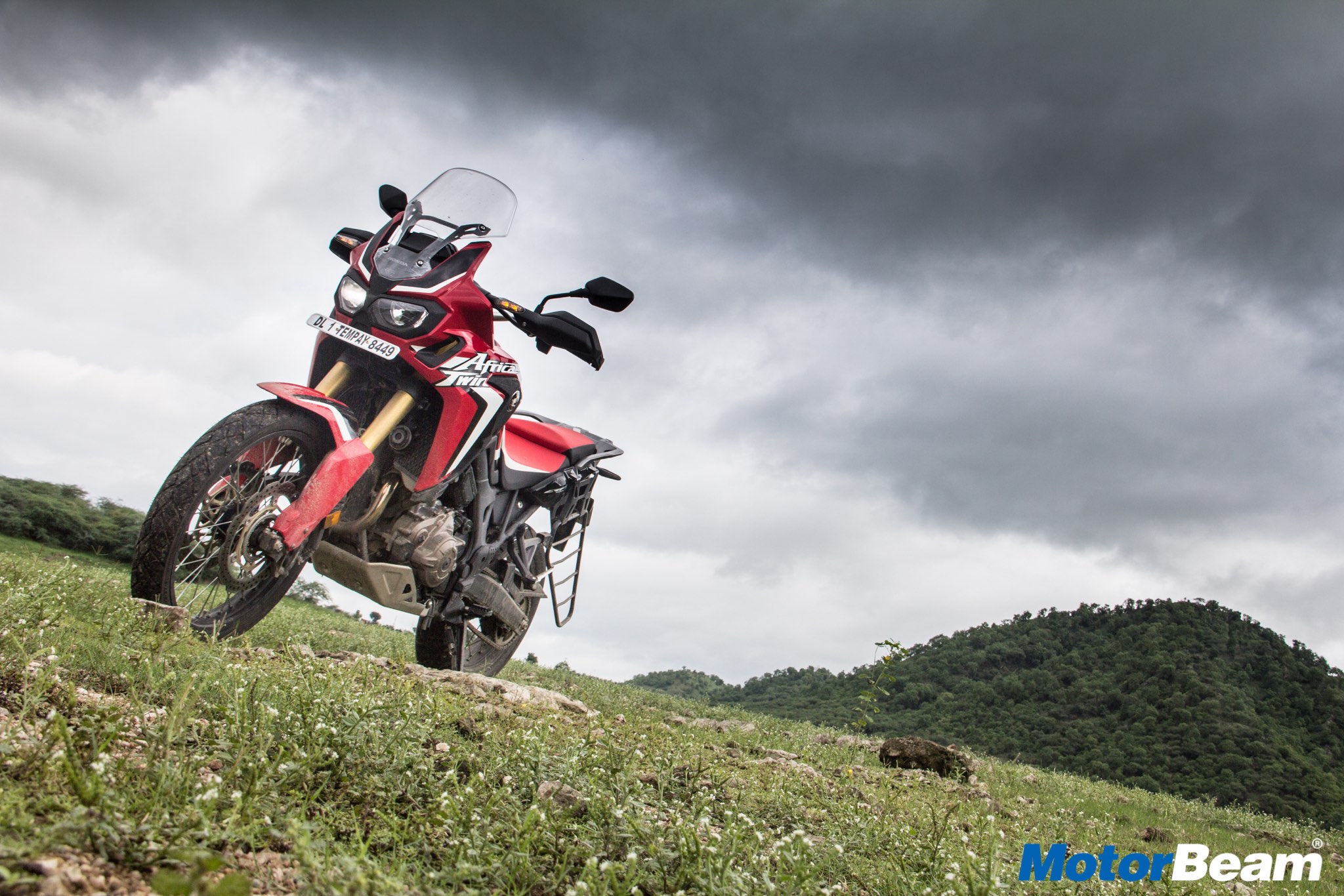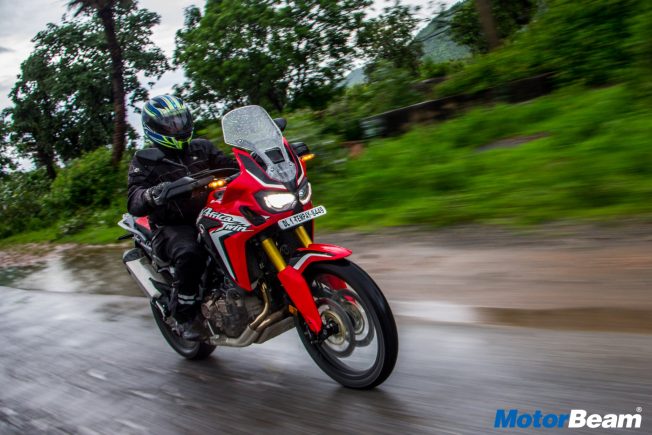
Honda Africa Twin Review
Bike Tested: Honda Africa Twin CRF1000L DCT; Road Test No. 848; Test Location: Udaipur
Price OTR Mumbai: Rs. 15,07,800/-
The Honda Africa Twin’s biggest USP is the seamless shifting DCT automatic gearbox
Honda is one such 2-wheeler company which likes to be the first in every segment. If you recollect, they were the first to bring a quarter-litre bike in India, which was manufactured with high local content. Then they were the first with a middle-weight 4-cylinder motorcycle, the CBR650F and now they have brought in the Africa Twin which is locally assembled via the CKD route but what stands out here is, it is the only motorcycle in India that is equipped with an automatic transmission. Yes, you read that right, a 1000cc adventure motorcycle with an automatic gearbox, what’s cooking here?
The Honda Africa Twin looks every bit ready for adventure
Styling – The Honda Africa Twin stays true to the adventure design philosophy by looking absolutely unconventional to a normal person. It takes inspiration from the Honda bikes which ruled the Dakar rally in the late 1980s. Up front, you get twin headlights while all the lights are LEDs. The nose is high, body is lean and stretched along with the hand guards, spoke wheels and long travel suspension that give it a whole lot of character. The rear design is a combination of both the CRF and CBR models. The only ugly bit is the saree guard.
The console is a vertical unit with a ton of information on display
Instrument Cluster and Switchgear – The console on this motorcycle is vertically stacked and shows a plethora of information. It is divided into four sections, the top one in the centre gets a speedometer, tachometer and fuel meter while the ones on either side are for the tell-tale lights. The one in the centre below displays all the modes, traction control, gear position indicator and other information like odoemter, trip meters, temperature, fuel consumption and clock.
The switchgear has top quality with loads of button for the electronics
Unlike the single-cylinder Honda motorcycles, the Africa Twin gets proper switchgear including an engine kill switch which also includes a starter button within. The right side of the handle features the riding mode buttons, hazard switch and the button to switch between automatic and manual transmission modes and also put the bike in neutral. On the left, there are plenty of buttons including the low-high beam switch with a pass light, horn, indicators, toggle select menu button, traction control button and gearshift buttons.
The Africa Twin has a comfortable seating position for long rides
Ergonomics – The Honda Africa Twin rides high but you can adjust your seat height between 820 mm (lowest) and 840 mm (highest). However, in some markets, the seat height runs between 850 to 870 mm. The seat is slim but still offers good comfort and little under-thigh support too while the pillion gets a more comfortable and wide seat and sits higher than the rider. The pegs are placed centre-set and the fixed windscreen cuts windblast to a certain extent although you have an accessory option for a higher windscreen. The handlebar is in easy reach but if you are short, you sit a bit leaned in.
The engine is refined but has the typical twin-cylinder rumble
Performance – The Honda Africa Twin, as the name suggests, is powered by a parallel-twin, litre-class engine which belts out 87 BHP and 91.9 Nm. This motor lacks low-end punch which is surprising as it redlines very early at just 8000 RPM, so the powerplay is in a very short RPM band. Once past 4000 RPM, the powertrain wakes up, changes its character and gets going ahead with gusto, It screams past the mid-range and redlines in an instant, 0-100 km/hr coming up in 3.8 seconds in second gear itself while top speed is just 190 km/hr. This powerplant is refined, as expected from a Honda but has the tradition twin-cylinder rumble and an adventure motorcycle feel one would expect.
The Africa Twin lacks bottom-end punch but excels in the mid-range
The parallel-twin motor has quite a short power band and one has to ring it hard
Mated to this mill is a 6-speed, dual-clutch automatic gearbox which does seamless shifts when you ride in D mode and you can switch to sports mode (on the fly) which has three levels (S1, S2 and S3) and the difference can be felt in every level as the rev shifts vary accordingly. You can also manually take control of the gearbox with the A/M switch while even in automatic mode, you can up or downshift using the gearshift buttons. The Africa Twin rides like a normal motorcycle in manual mode while there is a Gravel mode (G button on the right side ahead of the brake lever) to get an extra tap of power on the rear wheel when going on inclines, declines and off-roads.
The automatic gearbox means you can just focus on the experience
The feel of the throttle is very sharp after a certain point but lower down, it misses out on an initial push which the automatic gearbox does mask to a certain extent when riding in the city. The experience of riding an automatic motorcycle is quite unique and although there is a handbrake lever on the left, Honda has positioned it far ahead so you don’t misjudge it for a clutch, you can’t use it on the go, even if you try. Honda claims a mileage of 21 km/l on the Africa Twin, we got around 16 km/l. Honda has designed the fairing in such a way that no heat comes to the rider’s leg and is dissipated away right at the instance.
The ride and handling balance is excellent, brakes could be better
Riding Dynamics – The Honda Africa Twin is a heavy bike on paper and feels so at slow speeds, more so when taking a u-turn. However, when you start riding it, it feels light and nimble, offering good handling by adventure motorcycle standards. Although the suspension is on the stiffer side, ride quality is very compliant thanks to the long suspension travel. This Honda gets slim tube tyres and grip levels are just adequate, it could have done better with wider tyres.
The long travel suspension really helps but the tyres need to be grippier
The Africa Twin has a load of electronics and they all enrich the ride experience
The Africa Twin feels confident enough to be pushed till 140 km/hr but post that the loss in stability can be felt a little. However, where it excels is off the road with the traction off (there are three levels) as it brings out the full potential of this bike, coupled with the adventure set-up. The traction control system is quite intrusive and when you give it the beans, the light is constantly blinking as the electronics cut power. The difference in the various traction modes can be felt only in the first two gears. The motorcycle gets switchable ABS (the button is right next to G mode) which turns off ABS on the rear wheel for some off-road sliding fun. While braking performance is decent, on hard braking, the rear tends to step out.
This adventure motorcycle stands out with its automatic gearbox
Verdict – The Honda Africa Twin is a vivid motorcycle, offering a very different kind of riding experience, all thanks to the DCT gearbox. This adventure machine is at home in almost all kinds of terrain, be it city, highway or even off-road, you can tour on it too. The pricing is also very aggressive and given Honda’s Wing World network, service shouldn’t be an issue either. To conclude, the gearbox is the reason to buy or not buy this bike because if you are the conventional kind, you would want to shift gears on your own but if you want the seamless experience of just riding without having to worry, the Honda Africa Twin is the one for you.
The Africa Twin is very attractively priced and should sell well
What’s Cool
* The automatic gearbox shifts seamlessly
* The Africa Twin is capable on almost all kinds of terrain
* The electronics on this bike work very well
* Riding this adventure motorcycle is a unique experience
What’s Not So Cool
* Lacks low-end punch
* Could do with more stopping power
A smaller version of this adventure motorcycle please, Honda!
Honda Africa Twin Specifications
* Engine: 999.11cc, Twin-Cylinder, 4-Valve, Liquid-Cooled, OHC, SI, FI
* Power: 87 BHP @ 7500 RPM
* Torque: 91.9 Nm @ 6000 RPM
* Transmission: 6-speed dual-clutch automatic
* 0-100 km/hr: 3.8 seconds
* Top Speed: 190 km/hr
* Fuel Consumption: 15-22 km/l
* Fuel Type: Petrol
* Frame: Semi-Double Cradle
* Suspension: Inverted Telescopic Forks (Front), Pro-Link Monoshock (Rear)
* Tyres: 90/90/21 54H (Front), 150/70/18 70H (Rear), Tube Type
* Brakes: 310 mm Dual Discs (Front), 256 mm Disc (Rear), ABS
* Battery: 12V, 11.2 A-h
* Headlamp: 17W (High Beam), 18W (Low Beam), LEDs
Honda Africa Twin Dimensions
* Length x Width x Height (mm): 2334 x 932 x 1478
* Wheelbase: 1574 mm
* Seat Height: 820 – 840 mm (Adjustable)
* Ground Clearance: 250 mm
* Fuel Tank Capacity: 18.8-litres
* Kerb weight: 245 kgs





